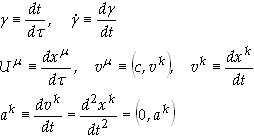
Coordinate
Acceleration
Back
to Physics World
Back to General Relativity
In
this page an expression is derived expressing the coordinate acceleration ak
= dvk/dt
in terms of the Christoffel symbols and coordinate velocities vk
= dxk/dt. Solving for ak
gives the final result for the coordinate acceleration [1]. Consider the
spacetime event X defined as follows:
X
= (ct, x, y, z) = (ct, r) = (x0,
x1,
x2,
x3)
In what follows the
following terms will be used

The 4-velocity can be represented in terms of the coordinate velocity as

Take the derivative of Eq. (1) with respect to proper time t to obtain

Eq.
(2) can be written in terms of components as

The geodesic equation can be expressed in terms of the coordinate velocity
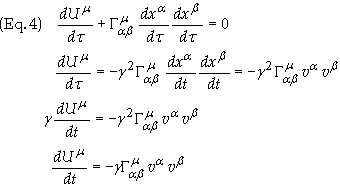
Gmab are the Christoffel Symbols (of the second kind) and are defined as
![]()
Substitute Eq. (3) into the geodesic equation Eq. (4), noting that
![]()
gives
![]()
Equating components in Eq. (7) gives

Substitute Eq. (8a) into Eq. (8b) and cancel g to give
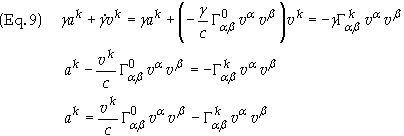
Eq. (9) is the result we are looking for, i.e. ak is the expression for the coordinate acceleration. It is noted that the result arrived at in Eq. (9) is identical to the result as obtained by Mould [1]
Application to a
Schwarzschild Field
In this section we will
use Eq. (10) to determine the coordinate acceleration for a particle in
free-fall in a Schwarzschild gravitational field. We will assume that the
particle is falling radially towards the center of the source. The metric for
such a field is given by

In order to simplify the
equations that follow define
![]()
The nonvanishing components of the metric tensor are
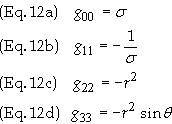
The components of the
metric form a diagonal matrix. The components of the inverse matrix is also
diagonal and are given by
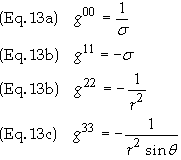
Since the particle is
falling radially, vq
= vf
= 0 , it follows that vm
= (v0,
v1,
v2,
v3)
= (c, vr,
vq,
vf)
= (c, vr,
0, 0). The radial acceleration is thus given by

We now seek to find the
Christoffel symbols used in Eq. (14). We start by noting that for the metric in
Eq. (12) the Christoffel symbols in Eq. (14) are defined as

Find
the non-vanishing Christoffel symbols:
G000: Use Eq. (15a) with a
= b
= 0 we obtain
![]()
G001: Use Eq. (15a) with a
= 0, b
= 1 we obtain

G011: Use Eq. (15a) with a
= 1, b
= 1 we obtain
![]()
G100: Use Eq. (15b) with a
= b
= 0 we obtain

G101: Use Eq. (15b) with a
=0, b
= 1 we obtain
![]()
G111: Use Eq. (15b) with a
= b
= 1 we obtain

Summary
of non-vanishing Christoffel symbols used in Eq. (14)
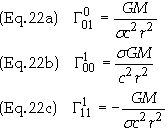
When the Christoffel
symbols in Eq. (22) and that vm =
(c, vr,
0, 0) are substituted into Eq. (14) we obtain
![]()
which reduces to
![]()
Substitute Eq. (22) into
(23) to obtain
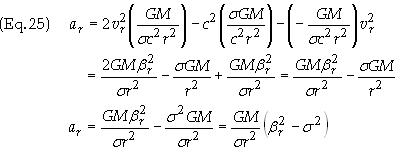
Mould’s result is [2]

References:
[1] Basic Relativity,
Richard A. Mould, Springer Verlag, (1994), p. 217, Eq. (7.57).
[2] Ref. 1, p. 329, Eq. (12.37)